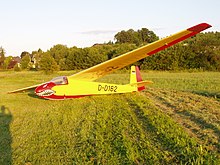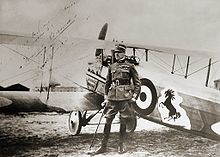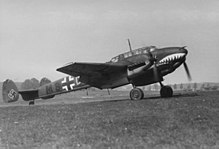Nose art





Nose art is a painting or drawing on the fuselage of an aircraft near the nose of the aircraft . It is usually used for decorative purposes. Nose art is a form of aircraft graffiti that is particularly common in military aviation.
history
The custom of applying individually designed decorations to combat aircraft can be traced back to Italian and German pilots. The first known nose art was a sea monster painted on an Italian flying boat in 1913 . German pilots introduced the tradition of painting mouths below the propeller hood, which was popular during World War I. An example of this is also Francesco Baracca and the Cavallino . Later, however, the ground crew, and no longer the pilots, devised and implemented the nose arts.
Some examples from World War I became famous, including the "Hat in the Ring" of the 94th Aero Squadron of USAAF (attributed to Lt. Johnny Wentworth) or the "Kicking Mule" of the 95th Aero Squadron . This followed the official policy of May 6, 1918, of Brigadier General Benjamin Foulois , commander of the Air Force of the American Expeditionary Forces , which required that each unit have its own unique and easily recognizable badge.
Due to economic restrictions were nose arts during the Great Depression in the Army Air Corps not common, but during the Second World War , the custom was to give airplanes a name, only baptized some of them, others elaborately decorated with cartoons and Pinups decorated, flourish again. Common themes were play on words and references to popular culture.
While nose art in World War I largely consisted of embellished or extravagant squadron badges, in the opinion of many observers the golden age of nose art began in World War II, in which the pilots of the Axis Powers and the Allies were equally involved. At the height of the war, the services of nose art artists in the Army Air Force were in great demand and well paid. In contrast to the AAF, in which the nose art was officially tolerated to raise the morale of the crews, the US Navy banned it . Nose art does not seem to have been commonplace in the RAF and RCAF either.
Both professional artists and talented military personnel performed the work. For example, in 1941 an artist from Bell Aircraft Corporation designed and painted an attractive “ Cobra in the Clouds” logo for the 39th Pursuit Squadron . In early 1943, the 39th became the first squadron with 100 kills in their theater of war. Out of pride and corps spirit , they adopted a shark's mouth as a motif for their P-38 Lightnings .
A lack of discipline combined with the burden of war and the high risk of losing one's life led to a scope and a quality of nose art that has not yet been achieved.
As a result of changes in military policy and changing attitudes towards portrayals of women, the scope of nose arts has steadily declined since the Korean War . However, since the Second Gulf War , nose art has experienced a revival, all the more since Operation Enduring Freedom and Operation Iraqi Freedom . The USAF unofficially approved the return of pinups, if only in their clothed state. Strategic Air Command also allowed nose art on its bombers again. In addition, the continuation of historical names such as Memphis Belle Tradition. Special operations squadrons usually referred to their AC-130 Gunships with names of revenge deities (" Thor ", " Azrael - Angel of Death"). The logo of a flying skeleton with a minigun was the unofficial gunship badge until after the war in Southeast Asia. The logo used on many aircraft was approved after the fact.
Nose art is largely a military tradition, but the passenger planes of the Virgin Group airlines have painted a "Virgin Girl" near the nose of the aircraft as part of their paint job. In a broader sense, the painting of vertical stabilizers, for example on Alaska Airlines or fighter planes of the US Navy , is to be regarded as nose art.
Because of its individual, unofficial nature, it is considered representative folk art that is inextricably linked to the activity of a particular group. It can also be compared to sophisticated graffiti . In both cases, the artist is by and large unknown and the art itself is ephemeral. To do this, it depends on materials that are immediately available.
In a few cases the artist could be identified. Tony Starcer was the artist on the site of the 91st Bomb Group, one of the Eighth Air Force's initial six bomber groups . Starcer painted over 100 well-known nose arts for the B-17 , including the one for the Memphis Belle . A commercial artist named Brinkmann was responsible for the zodiac theme for the B-24 Liberator- armed 834th Bomb Squadron.
purpose
Started for practical reasons to distinguish friend from foe, nose art continued to develop. It had its use in morality and the expression of pride. In addition, it helped to ease the uniform anonymity of the military and offered consolation by reminding of life at home or in peacetime. In addition, she served as a fetish in the fight against the enemy. Part of the appeal was its unofficial character, although the service regulations were not strictly enforced or not enforced at all.
Content
The templates were varied: from pinups (such as Rita Hayworth ), symbols of patriotism ( Yankee Doodle ) and fictional heroes ( Sam Spade ) to symbols of luck such as dice and playing cards to caricatures , the inevitable symbols of death or the grim reaper . Caricatures and pinups were the most popular among American artists. Other popular themes included animals, nicknames, hometowns, and common song and movie titles.
Nose arts were less common in the German Air Force. During the Civil War , however ed a Mickey Mouse an Bf 109 and a pig inside a white circle the paneled suspension of Ju-87A -Sturzkampfflugzeuge the so-called after a comedy of August Hinrichs designated "Jolanthe-chain" of the legion Condor . A Ju 87B-1 (S2 + AC) of the Stab II / St.G 77 stationed in Breslau - Schongarten , flown by Major Alfons Orthofer during the attack on Poland in 1939, was painted with a shark's mouth and some Bf 110s with grim wolf heads or shark mouths decorated on the hoods. Another example was the Bf 109 by Erich Hartmann, decorated with a tulip pattern .
The air forces of the Soviet Union decorated their planes with historical figures, monsters from the legendary world and patriotic motifs.
The further the planes and crews were from their headquarters or out of the public eye, the more daring the nose art design was. For example, nude pinups were much more common on aircraft based in Oceania than in England.
Famous examples
One of the most well-known nose art motifs is the sharkmouth , which is used in various air forces to this day. The first use in World War II can be traced back to the Destroyer Squadron 76 (ZG 76), later the 112th ( Kittyhawk ) Squadron of the RAF in North Africa used this motif. The Flying Tigers then used the shark's mouth on their P-40s.
One of the most elaborate works was carried by the B-24 "The Dragon And His Tail" by the 22nd Bomb Group. Here the "nose art" extended over the entire length of the right side of the fuselage. Also known was the "bat nose art" on the B-25 of the 499th Bomb Squadron, which was nicknamed "Bats outa hell".
Individual evidence
- ↑ George Petty : (centerfold girl) . In: Esquire . April 1941. Hearst Corporation , New York City 1941, p. 39-40 ( esquire.com [accessed August 9, 2019]).
- ↑ a b AFHRA at Maxwell AFB
- ↑ a b c d e How nose art and pin-ups boosted WWII USAAF troops' moral article on BBC News
- ↑ a b A short history of the 39th Fighter Squadron
- ↑ Griffith.
- ↑ Ethell, p. 14th
- ↑ Nose art article on the University of Arizona website.
- ↑ McDowell, p. 8-9.
- ↑ Photos of the "Dragon And His Tail"
- ↑ Drawing of a B-25 of the 499th Bomb Squadron "Bats outa hell"
literature
- Velasco, Gary Velasco, FIGHTING COLORS The Creation of Military Aircraft Nose Art . Turner Publishing, 2004.
- Campbell, John M. & Donna, War Paint . Shrewsbury, 1990.
- Chinnery, Philip, Desert Boneyard: Davis Monthan AFB Arizona . Osceola, Wisconsin: Motorbooks, International, 1987.
- Cohan, Phil, "Risque Business." Air and Space 5 (Apr-May 1990): 62-71.
- Davis, Larry, Planes, Names and Dames: 1940-1945 . Vol. 1. Carrollton, Texas: Squadron / Signal Publications, 1990.
- Davis, Larry, Planes, Names and Dames: 1946-1960 . Vol. 2. Carrollton, Texas: Squadron / Signal Publications, 1990.
- Davis, Larry, Planes, Names and Dames: 1955-1975 . Vol. 3. Carrollton, Texas: Squadron / Signal Publications, 1990.
- Dorr, Robert F., Fighting Colors: Glory Days of US Aircraft Markings . Osceola, Wisconsin: Motorbooks International, 1990.
- Ethell, Jeffrey L., The History of Aircraft Nose Art: World War I to Today . Osceola, Wisconsin: Motorbooks International, 1991.
- Fugere, Jerry, Desert Storm B-52 Nose Art . Tucson, AZ: J. Fugere, 1999.
- Logan, Ian, Classy Chassy . New York: WW Visual Library, 1977.
- March, Peter R., Desert Warpaint . London: Osprey Aerospace, 1992.
- McDowell, Ernest R., The P-40 Kittyhawk at War . New York: Arco Publishing, 1968.
- O'Leary, Michael D., "Disney Goes to War!" Air Classics 32, no.5 (1996): 40-42, 45-51.
- Valant, Gary M., Vintage Aircraft Nose Art . Osceola, Wisconsin: Motorbooks International, 1987.
- Walker, Randy, Painted Ladies . West Chester, Pennsylvania: Schiffer Publishing, 1992.
- Walker, Randy, More Painted Ladies . Atglen, Pennsylvania: Schiffer Publishing, 1994.



